Solar eclipse of March 7, 1970
A total solar eclipse occurred on Saturday, March 7, 1970, visible across most of North America and Central America.[1][2][3][4][5]
| Solar eclipse of March 7, 1970 | |
|---|---|
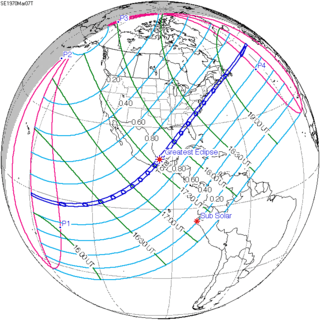 Map | |
| Type of eclipse | |
| Nature | Total |
| Gamma | 0.4473 |
| Magnitude | 1.0414 |
| Maximum eclipse | |
| Duration | 208 sec (3 m 28 s) |
| Coordinates | 18.2°N 94.7°W |
| Max. width of band | 153 km (95 mi) |
| Times (UTC) | |
| Greatest eclipse | 17:38:30 |
| References | |
| Saros | 139 (27 of 71) |
| Catalog # (SE5000) | 9442 |
A solar eclipse occurs when the Moon passes between Earth and the Sun, thereby totally or partly obscuring the image of the Sun for a viewer on Earth. A total solar eclipse occurs when the Moon's apparent diameter is larger than the Sun's, blocking all direct sunlight, turning day into darkness. Totality occurs in a narrow path across Earth's surface, with the partial solar eclipse visible over a surrounding region thousands of kilometres wide.
Totality was visible across southern Mexico and the Gulf of Mexico, the southeast Atlantic coast of the United States, northeast to the Maritimes of eastern Canada, and northern Miquelon-Langlade in the French overseas collectivity of Saint Pierre and Miquelon.[6]
Greatest eclipse occurred over Mexico at 11:38 am CST, with totality lasting 3 minutes and 28 seconds. Totality over the U.S. lasted up to 3 minutes and 10 seconds.[7] The media declared Perry as the first municipality in Florida to be in the eclipse direct path.
Inclement weather obstructed the viewing from that location and most of the eclipse path through the remainder of the southern states. There will not be an eclipse with a greater duration of totality over the contiguous U.S. until April 8, 2024, a period of 54 years.
Scientific effects
This eclipse slowed a radio transmission of atomic time from North Carolina to Washington, D.C.[8]
Images
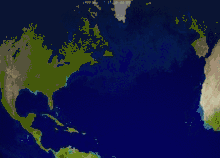
Related eclipses
Solar eclipses of 1968–1971
This eclipse is a member of a semester series. An eclipse in a semester series of solar eclipses repeats approximately every 177 days and 4 hours (a semester) at alternating nodes of the Moon's orbit.[9]
| Solar eclipse series sets from 1968–1971 | ||||||
|---|---|---|---|---|---|---|
| Ascending node | Descending node | |||||
| Saros | Map | Saros | Map | |||
| 119 | 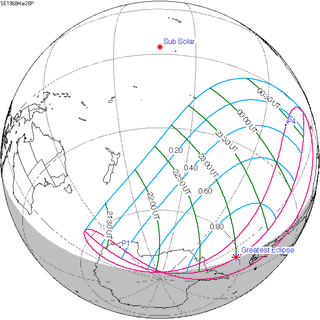 1968 March 28 Partial |
124 | 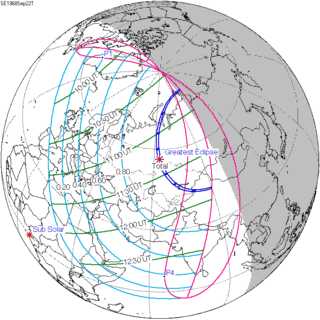 1968 September 22 Total | |||
| 129 |  1969 March 18 Annular |
134 |  1969 September 11 Annular | |||
| 139 |  1970 March 7 Total |
144 |  1970 August 31 Annular | |||
| 149 |  1971 February 25 Partial |
154 | 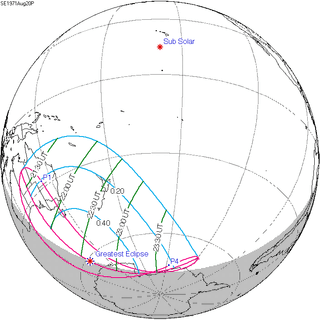 1971 August 20 Partial | |||
| A partial solar eclipse of July 22, 1971 occurs in the next lunar year set. | ||||||
Saros 139
It is a part of saros series 139, repeating every 18 years, 11 days, 8 hours, containing 71 events. The series started with partial solar eclipse on May 17, 1501. It contains hybrid eclipses on August 11, 1627 through December 9, 1825 and total eclipses from December 21, 1843 through March 26, 2601. The series ends at member 71 as a partial eclipse on July 3, 2763. Members in the same column are one exeligmos apart and thus occur in the same geographic area.
The solar eclipse of June 13, 2132 will be the longest total solar eclipse since July 11, 1991 at 6 minutes, 55.02 seconds.
The longest duration of totality will be produced by member 39 at 7 minutes, 29.22 seconds on July 16, 2186.[10] This is the longest solar eclipse computed between 4000BC and 6000AD.[11]
After 16 July 2186, totality duration will decrease. All eclipses in this series occurs at the Moon’s ascending node.
| Series members 24–45 occur between 1901 and 2300 | ||
|---|---|---|
| 24 | 25 | 26 |
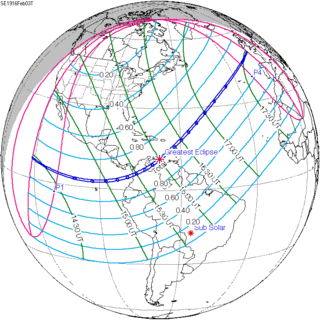 February 3, 1916 |
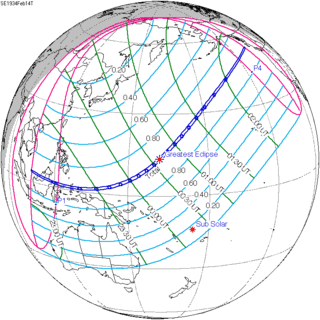 February 14, 1934 |
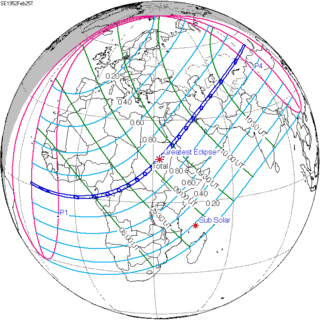 February 25, 1952 |
| 27 | 28 | 29 |
 March 7, 1970 |
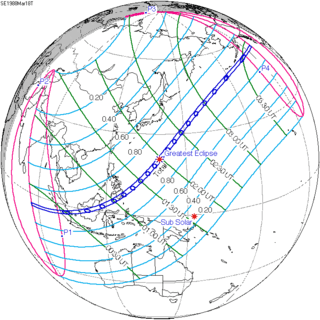 March 18, 1988 |
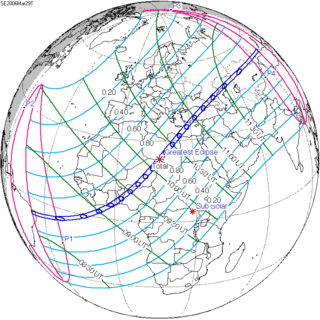 March 29, 2006 |
| 30 | 31 | 32 |
 April 8, 2024 |
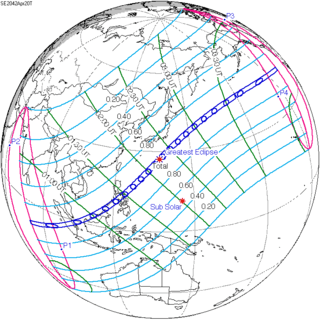 April 20, 2042 |
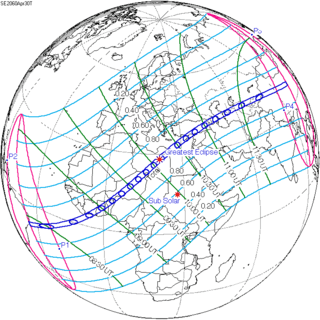 April 30, 2060 |
| 33 | 34 | 35 |
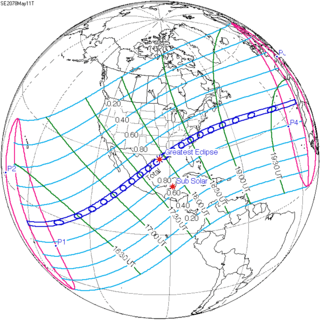 May 11, 2078 |
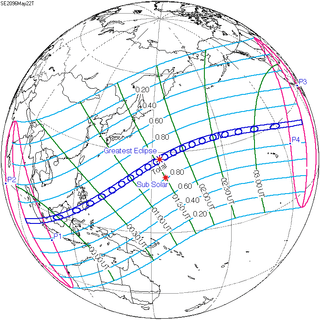 May 22, 2096 |
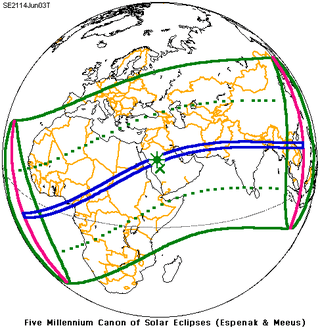 June 3, 2114 |
| 36 | 37 | 38 |
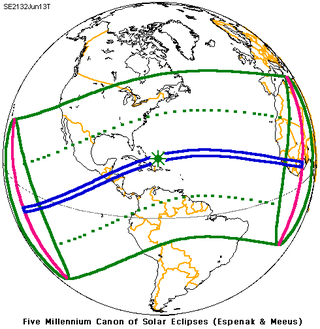 June 13, 2132 |
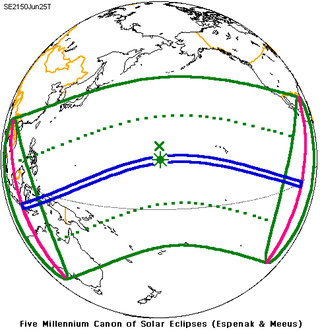 June 25, 2150 |
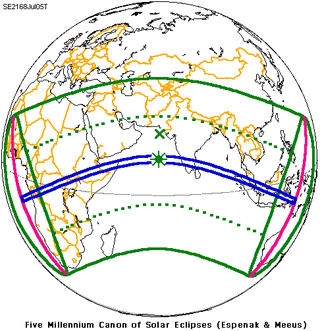 July 5, 2168 |
| 39 | 40 | 41 |
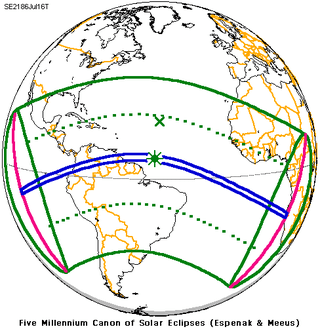 July 16, 2186 |
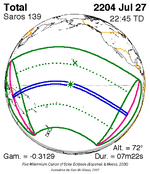 July 27, 2204 |
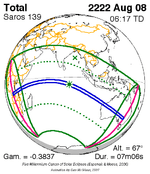 August 8, 2222 |
| 42 | 43 | 44 |
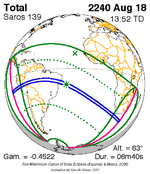 August 18, 2240 |
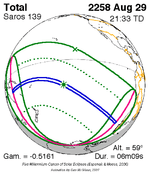 August 29, 2258 |
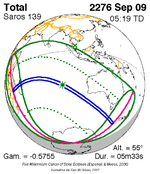 September 9, 2276 |
| 45 | ||
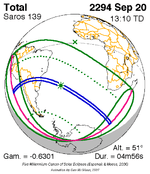 September 20, 2294 | ||
Tritos series
This eclipse is a part of a tritos cycle, repeating at alternating nodes every 135 synodic months (≈ 3986.63 days, or 11 years minus 1 month). Their appearance and longitude are irregular due to a lack of synchronization with the anomalistic month (period of perigee), but groupings of 3 tritos cycles (≈ 33 years minus 3 months) come close (≈ 434.044 anomalistic months), so eclipses are similar in these groupings.
| Series members between 1901 and 2100 | |||
|---|---|---|---|
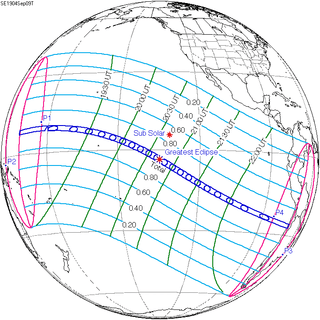 September 9, 1904 (Saros 133) |
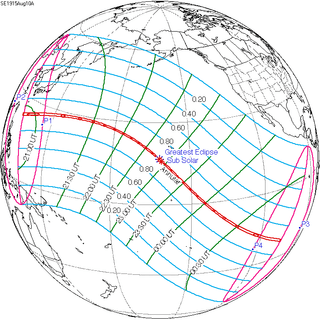 August 10, 1915 (Saros 134) |
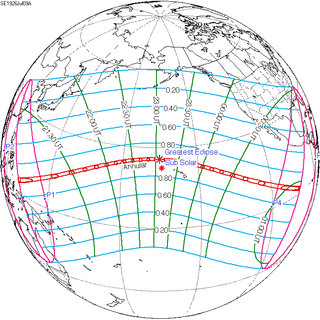 July 9, 1926 (Saros 135) | |
 June 8, 1937 (Saros 136) |
 May 9, 1948 (Saros 137) |
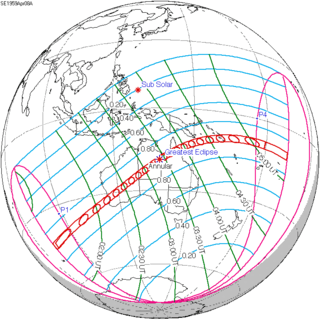 April 8, 1959 (Saros 138) | |
 March 7, 1970 (Saros 139) |
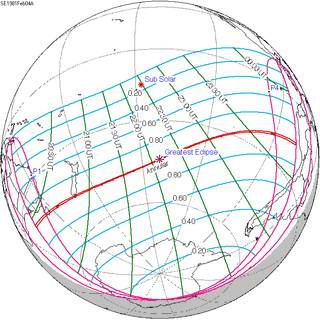 February 4, 1981 (Saros 140) |
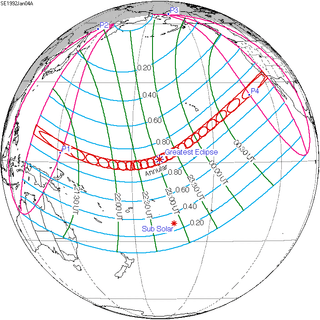 January 4, 1992 (Saros 141) | |
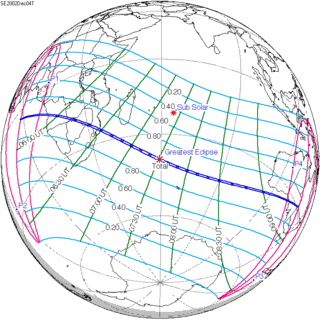 December 4, 2002 (Saros 142) |
 November 3, 2013 (Saros 143) |
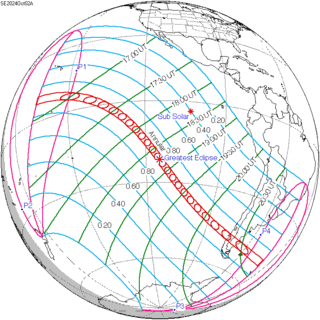 October 2, 2024 (Saros 144) | |
 September 2, 2035 (Saros 145) |
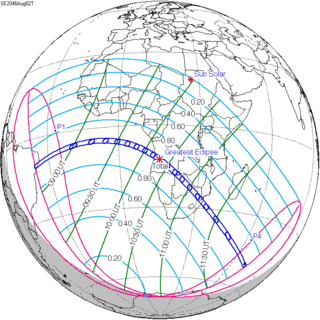 August 2, 2046 (Saros 146) |
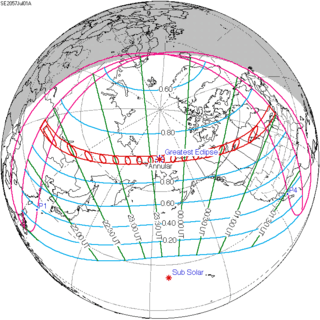 July 1, 2057 (Saros 147) | |
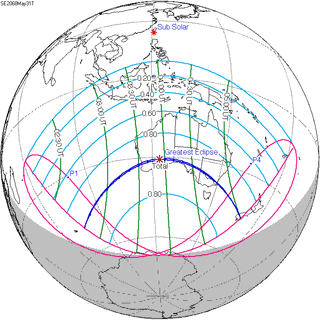 May 31, 2068 (Saros 148) |
 May 1, 2079 (Saros 149) |
 March 31, 2090 (Saros 150) | |
Metonic series
The metonic series repeats eclipses every 19 years (6939.69 days), lasting about 5 cycles. Eclipses occur in nearly the same calendar date. In addition, the octon subseries repeats 1/5 of that or every 3.8 years (1387.94 days). All eclipses in this table occur at the Moon's ascending node.
| 22 eclipse events between December 24, 1916 and July 31, 2000 | ||||
|---|---|---|---|---|
| December 24–25 | October 12–13 | July 31-Aug 1 | May 18–20 | March 7–8 |
| 91 | 93 | 95 | 97 | 99 |
| December 23, 1878 | October 12, 1882 | July 31, 1886 | May 18, 1890 | March 7, 1894 |
| 101 | 103 | 105 | 107 | 109 |
| December 23, 1897 | October 12, 1901 | August 1, 1905 | May 19, 1909 | March 8, 1913 |
| 111 | 113 | 115 | 117 | 119 |
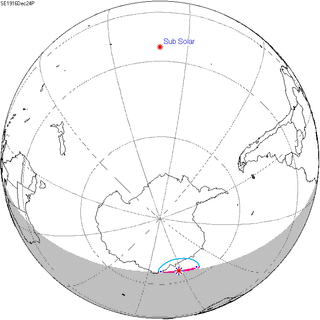 December 24, 1916 |
October 12, 1920 | 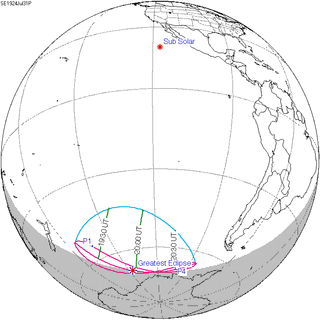 July 31, 1924 |
 May 19, 1928 |
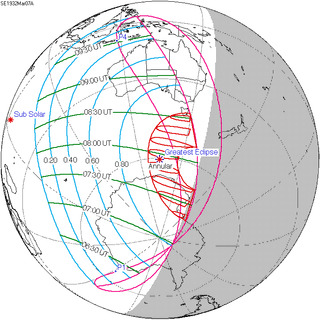 March 7, 1932 |
| 121 | 123 | 125 | 127 | 129 |
 December 25, 1935 |
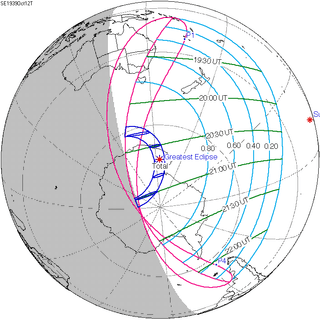 October 12, 1939 |
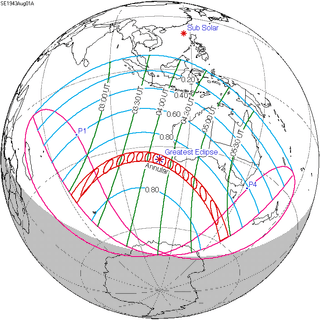 August 1, 1943 |
 May 20, 1947 |
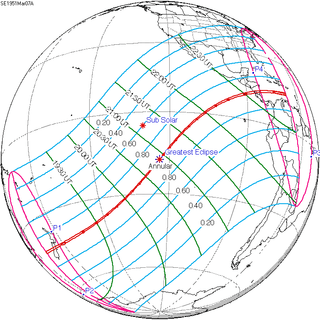 March 7, 1951 |
| 131 | 133 | 135 | 137 | 139 |
 December 25, 1954 |
 October 12, 1958 |
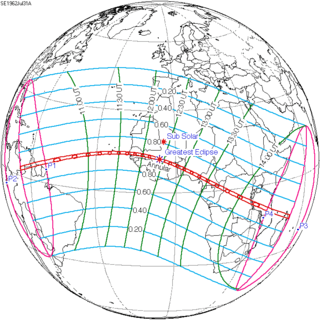 July 31, 1962 |
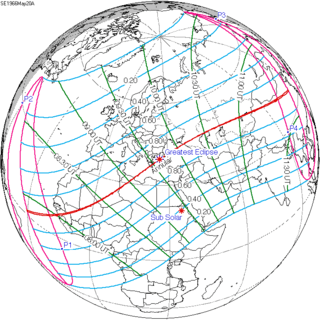 May 20, 1966 |
 March 7, 1970 |
| 141 | 143 | 145 | 147 | 149 |
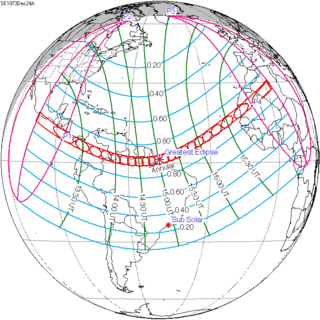 December 24, 1973 |
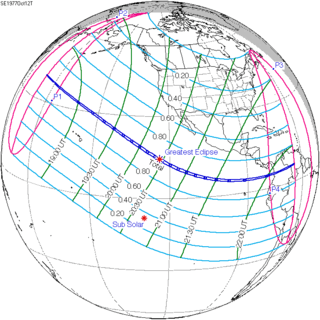 October 12, 1977 |
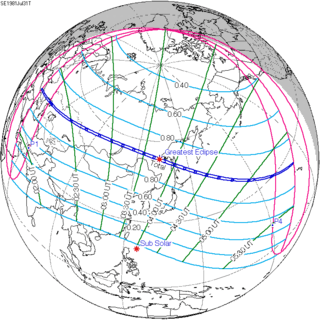 July 31, 1981 |
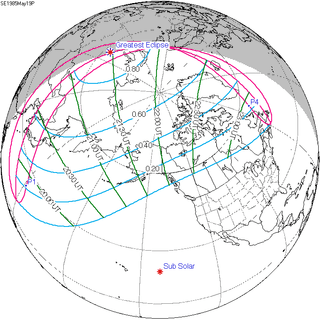 May 19, 1985 |
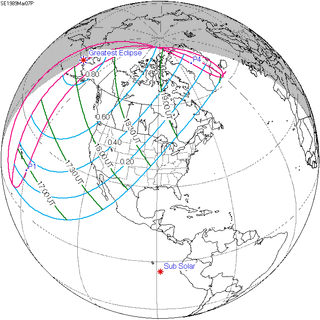 March 7, 1989 |
| 151 | 153 | 155 | 157 | 159 |
 December 24, 1992 |
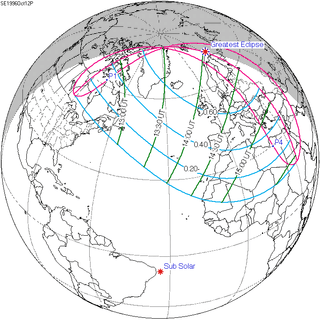 October 12, 1996 |
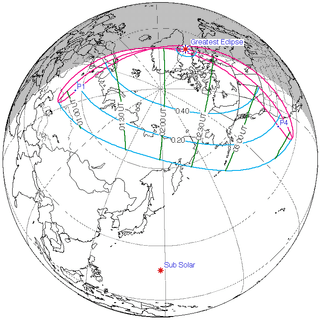 July 31, 2000 |
May 19, 2004 | March 7, 2008 |
| 161 | 163 | 165 | 167 | 169 |
| December 24, 2011 | October 13, 2015 | August 1, 2019 | May 19, 2023 | March 8, 2027 |
In popular culture
CBS first color broadcast of a total eclipse.[12][13][14][15][16][17][18][19]
The eclipse may be referenced in the hit popular song “You're So Vain” by Carly Simon, although this may refer to a different eclipse.
Notes
- "Spell cast by eclipse". Spokane Daily Chronicle. (Washington). UPI. March 7, 1970. p. 1.
- "Sun, Moon, Earth fall into step". Free Lance-Star. (Fredericksburg, Virginia). Associated Press. March 7, 1970. p. 1.
- "Scientists get great view of solar eclipse in Mexico". Toledo Blade. (Ohio). Associated Press. March 8, 1970. p. 1.
- "Great shadow crosses Earth as millions watch in awe". Sarasota Herald-Tribune. (Florida). Associated Press. March 8, 1970. p. 1.
- Quigg, H.D. (March 8, 1970). "Seaboard 'oohs' as Ol' Sol blinks". Reading Eagle. (Pennsylvania). UPI. p. 1.
- Blakeslee, Alton (March 7, 1970). "Total solar eclipse visible in East today". Pittsburgh Post-Gazette. p. 1.
- Espenak, Fred. "Total Solar Eclipse of 1970 Mar 07". NASA Eclipse Website. Goddard Space Flight Center. Retrieved 3 June 2014.
- Sadeh, D. (1971), Phase variation of a very accurate radio frequency signal due to the solar eclipse, J. Geophys. Res., 76(34), 8427–8429, doi:10.1029/JA076i034p08427
- van Gent, R.H. "Solar- and Lunar-Eclipse Predictions from Antiquity to the Present". A Catalogue of Eclipse Cycles. Utrecht University. Retrieved 6 October 2018.
- Saros Series Catalog of Solar Eclipses NASA Eclipse Web Site.
- Ten Millennium Catalog of Long Solar Eclipses, -3999 to +6000 (4000 BCE to 6000 CE) Fred Espenak.
- Mike Kentrianakis (10 March 2010). "Solar Eclipse 1970 March 7 CBS News 1 of 6". Retrieved 20 May 2017 – via YouTube.
- Mike Kentrianakis (10 March 2010). "Solar Eclipse 1970 March 7 CBS News 2 of 6". Retrieved 20 May 2017 – via YouTube.
- Mike Kentrianakis (10 March 2010). "Solar Eclipse 1970 March 7 CBS News 3 of 6". Retrieved 20 May 2017 – via YouTube.
- Mike Kentrianakis (10 March 2010). "Solar Eclipse 1970 March 7 CBS News 4 of 6". Retrieved 20 May 2017 – via YouTube.
- Mike Kentrianakis (10 March 2010). "Solar Eclipse 1970 March 7 CBS News 5 of 6". Retrieved 20 May 2017 – via YouTube.
- Mike Kentrianakis (10 March 2010). "Solar Eclipse 1970 March 7 CBS News 6 of 6". Retrieved 20 May 2017 – via YouTube.
- "60 Years Ago: The World's 1st Televised Solar Eclipse". space.com. Retrieved 20 May 2017.
- "NASA Remembers 1970 Solar 'Eclipse of the Century'". space.com. Retrieved 20 May 2017.
References
- Earth visibility chart and eclipse statistics Eclipse Predictions by Fred Espenak, NASA/GSFC
Maps:
News:
Photos and observations
- Russia expedition
- Foto Solar eclipse of March 7, 1970
- Solar Eclipse Photo Gallery 1 1970–1984, Photographs by Fred Espenak, from Windsor, NC
- Observations of coronal polarization at the solar eclipse of 7 March, 1970 Polarigraphic observations of the 7 March 1970 eclipse were made at Miahuatlán (Mexico)
- Solar Eclipse of March 7, 1970 Williamston, NC by Gerard M Foley
.jpg)
